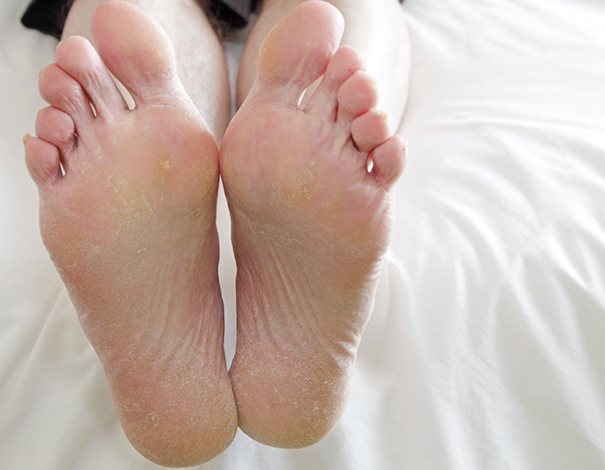Athlete’s foot
Contrary to what you might think, athletes aren’t the only ones who get athlete's foot. In fact, this infection caused by a fungus that grows between the toes is quite common. Learn how to stop athlete’s foot in its tracks.
What is athlete’s foot?
Athlete's foot is a fungal infection that usually appears between the toes, often between the third, fourth and fifth toe, as these warm, moist environments are ideal places for a fungus to thrive. Because it is contagious, athlete’s foot can spread to any part of the foot, including the toenails. If left untreated, athlete's foot can lead to toenail fungus.
If you have athlete’s foot, you may experience one or more of the following symptoms:
- itching
- burning
- cracked and scaly skin
- redness and irritation
- inflammation

Who is at risk of getting athlete’s foot?
Athlete’s foot is most common in men and adolescents. Factors that increase your risk of getting athlete’s foot include walking barefoot in warm, damp places such as in locker rooms and around public pools; having sweaty feet; or having a history of eczema or a weakened immune system (e.g., from HIV).
Athlete’s foot is also more common in the summer, when warm, moist conditions promote fungal growth.
When should you see a doctor?
Pharmacies sell a wide range of products to prevent and treat athlete's foot. However, you should see a doctor or a podiatrist if:
- The person is under 12.
- The fungus has spread to the nail.
- The pain is severe and/or the area appears to be infected (i.e., it is inflamed, swollen and draining pus).
- You see no improvement after two weeks of treatment.
- You still have blisters after six weeks of treatment.
- You have diabetes or a weakened immune system (e.g., you have HIV or are taking immunosuppressive drugs).
Athlete’s foot prevention
Athlete's foot often comes back. Follow these simple tips to avoid getting infected and prevent the infection from returning.
Keep your feet dry
Dry your feet thoroughly—especially between the toes—after taking a bath or shower or after swimming. Use a hair dryer if you have to, but be careful not to burn yourself! If your feet get very sweaty, apply an antiperspirant or talcum powder.
Wear shoes made of breathable materials
If your shoes get wet or damp, make sure to air them out so they are completely dry before you put them on again. In summer, wear sandals so your feet can breathe. What you wear in your shoes is equally important: cotton socks are better than those made of synthetic fibres. Last but not least, keep your feet dry by changing your socks as often as necessary throughout the day.Stop athlete’s foot from spreadingTo stop the fungus from spreading to other parts of your body or to other people, do not:
- Share your socks, shoes or towels with anyone.
- Touch the blisters; always wash your hands immediately after touching your feet.
- Walk barefoot around the house or in public places, such as at a public swimming pool, in locker rooms, or in public showers at the gym. Always wear shoes, socks or sandals.
Athlete’s foot treatment
People who have already contracted athlete’s foot can use an antifungal powder to reduce the risk of reinfection.
To get rid of athlete's foot, you can use an antifungal cream, which kills the fungus. The cream must be applied every day to be effective, usually for a period of two to four weeks. First , wash the affected area with mild soap and water and then thoroughly dry it. Next, apply a thin layer of cream over the affected area and about two centimetres beyond to make sure you kill all the fungi. Expect to wait a few days before seeing any improvement. You should also continue treatment for several days after the blisters have disappeared, as the fungus may still be on the skin, even if you can’t see it with the naked eye. Continuing treatment after the symptoms have gone increases the chance that the infection won’t return.
Many antifungals are available over the counter. For more information about them, talk to your pharmacist, who will be happy to tell you which one is best for your particular situation.
The pharmacy services presented in this section are offered by pharmacist owners who are affiliated with Uniprix. The pharmacists are solely responsible for the professional activities carried out during the practice of pharmacy. These services are offered in participating pharmacies only. Certain fees and conditions may apply.
* The information contained herein is provided for informational purposes only and is not intended to provide complete information on the subject matter or to replace the advice of a health professional. This information does not constitute medical consultation, diagnosis or opinion and should not be interpreted as such. Please consult your health care provider if you have any questions about your health, medications or treatment.
